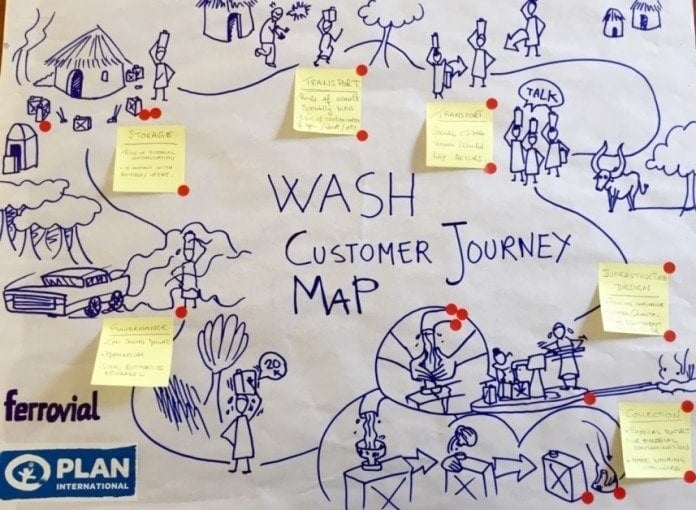
20 litres of water on their heads. The daily routine of the women of Uganda
The key role of women in Uganda in a society that revolves around water.
27 of September of 2016
The two weeks between 4 and 18 April were a turning point not only in my career, but also in my personal life. Thanks to Ferrovial’s corporate volunteering programme, along with other company employees I had the opportunity to learn about and support the work that the NGO Plan International Uganda is performing in this country and more specifically the interventions carried out in the districts of Kamuli and Buyende.
The collaboration between Ferrovial and Plan International is carried out within the framework of Ferrovial’s Social Infrastructures programme, the vehicle for international cooperation in water and sanitation-related projects. In the case of the project I visited the goal is to improve access to high quality potable water in 15 rural communities in the Buyende district, which will benefit more than 13,000 people.
Access to services as basic as electric power and healthy water is still only a dream in many rural areas of Uganda. Our mission as volunteers was to support the Plan NGO’s project, providing proposals for improvement in terms of water quality, location, communication/diffusion behaviour change and innovation from an external point of view.
As an expert in relations with third parties in projects in which Ferrovial has a presence in London, one of the main concerns that I faced before starting this adventure, was whether my experience in the UK would be transferable to a so different from London place as is Uganda.
During the first week, through visits to the beneficiary communities, we held conversations with the NGO, local authorities and members of water boards and visited previously constructed and operating wells, both successful ones and others not so successful… We volunteers were given first-hand insight into the base conditions and the main challenges to be overcome to enable implementation of the project. This enabled us to understand the backdrop of statistics as shocking as the following:
- 71,5% of the communities in the Buyende district do not have access to water (2013-14).
- Collecting water takes an average of 30-45 minutes per day, and the task mainly falls to the women and children. This can create social problems such as insecurity along the route and/or school absenteeism.
- Average water consumption in rural areas is 10 litres per person per day and the national goal is 20 litres.
- Many of the wells built are abandoned or neglected a few years after construction due to the lack of proper management and maintenance.
To help us identify the improvement areas one of the colleagues on the trip, Rosa Sanchís, an expert on innovation, introduced the group to a marketing tool known as the “Customer Journey Map”. This tool provides photograph of the user’s experience by means of key points and helps to structure visualisation of opportunities at a glance. And it was a surprise when another volunteer, José García Guaita, an expert in digital communication, picked up a marker and drew the user journey map with this brilliant illustration:
From the point of view of enhancing relations with third parties, behavioural change and governance in relation to the wells, we noted that women and children are a critical and decisive aspect of success in the change process.
[inlinetweet prefix=”” tweeter=”” suffix=””]In the majority of cases the journey from home to well is more than two kilometres.[/inlinetweet] The time spent on this daily trip, in addition to the obvious function of collecting water, has the social function of [text missing] We have, therefore, an opportunity to implement communication methods to engage this powerful sector of society.
One of the main proposals developed to drive adoption of healthy sanitation measures was the introduction of gamification as an educational tool for change. Gamification is the use of game mechanisms in non-recreational environments and applications in order to enhance motivation, concentration, effort, loyalty and other positive values common to all games. It constitutes a new and powerful strategy to influence and motivate groups of people. In line with this idea we proposed the introduction of game items throughout the “journey”, for example small panels with checkboxes joined to the toilets and wells. In schools we were inspired by an idea, already used in other projects, that involves building constructions with Lego bricks.
In addition to gamification, other proposals included the introduction of sanitation certificates, installation of signals and training of more mechanics to ensure maintenance of the wells.
I cannot end this article without paying homage to the women of Uganda who, as in all cultures, are the key element in sustainable development and progress. To them, the powerful and cordial women of the Nkondo community, I dedicate this post. Thanks also to the volunteer team and our leader on this unforgettable adventure, José Sastre.







There are no comments yet